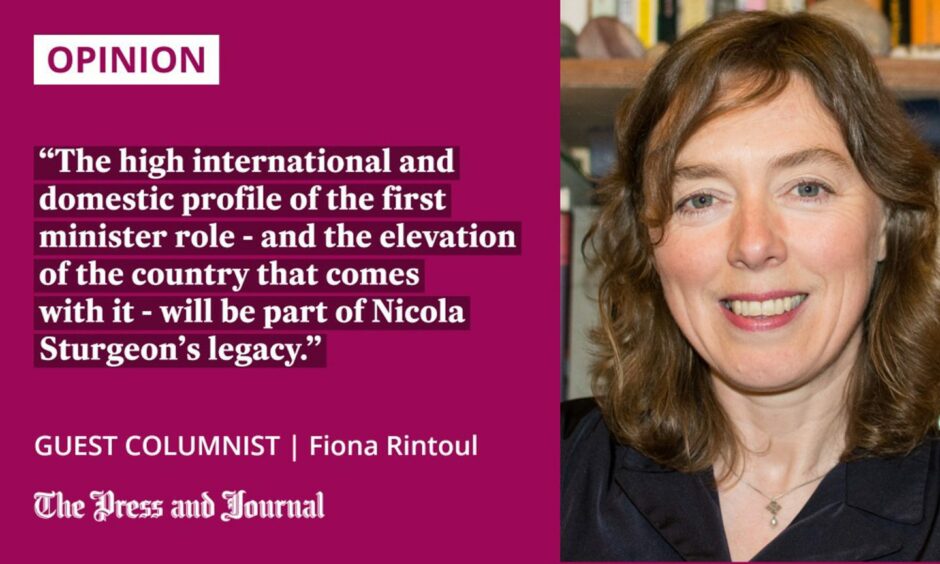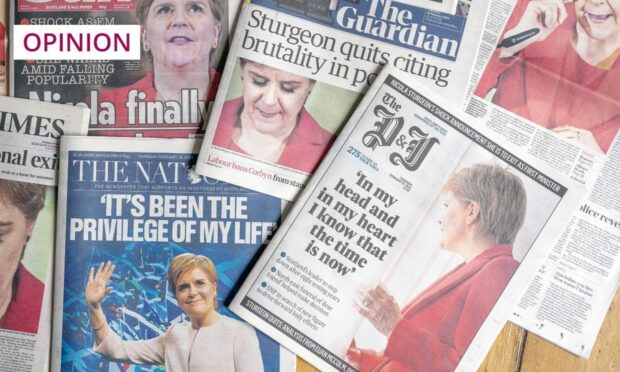Scotland’s first minister is renowned and admired globally for good reason, but the country needs new leadership, writes Fiona Rintoul.
I’m old enough to remember when people in England typically couldn’t name Scotland’s first minister.
Today, Nicola Sturgeon is one of the most recognised politicians across the United Kingdom – and one of the most admired. People know who she is in Paris, Berlin and New York, never mind London.
The high international and domestic profile of the first minister role – and the elevation of the country that comes with it – will be part of Nicola Sturgeon’s legacy. When I hitch hiked across Europe in my twenties, I spent half my time explaining that Scotland wasn’t part of England to the people who gave me lifts. Such discussions are now redundant, indeed, unimaginable.
That is a good thing. It is brilliant. It’s a gift from the Scottish parliament. In the hands of Nicola Sturgeon and Alex Salmond (whatever his flaws) before her, Holyrood has both allowed Scotland to carve its own political path and to have a distinctive voice that is heard throughout the world.

Boy, do we need that voice. For so many reasons. Because small countries see things differently. Because countries with more than one national language appreciate subtleties that are lost on monoglot nations. Because the Westminster voice remains, for the most part, one of excessive wealth and privilege. You can count on one hand the number of UK prime ministers who were educated at an ordinary state school, as most of us are, and as Nicola Sturgeon was.
That matters – perhaps more than we sometimes realise. It sets the tone. And the tone at Holyrood is emphatically inclusive in terms of race, religion, sex, social class and physical abilities. Nicola Sturgeon’s tenure has embedded that good.
But I’m not sorry that she has resigned. It was time. And it is perhaps one of her greatest achievements – possibly born of her ordinariness – to have realised that.
Sturgeon lost her touch with gender recognition reform
Announcing her intention to go at Bute House on Wednesday, she was her old self: relaxed, funny, warm. It was a far cry from the painful interviews of just a few days previously that followed the incarceration of a convicted rapist in a women’s prison.
In those conversations, the first minister, who normally impresses with her honesty and clarity, stumbled and obfuscated. She refused to say if Isla Bryson, who committed two rapes as Adam Graham, was a man or a woman. It began to look like it was over, and it turns out it was.
🏴 To all the people of Scotland – whether you voted for me or not – please know that being your First Minister has been the privilege of my life.
Nothing – absolutely nothing – I do in future will ever come close.
Thank you from the bottom of my heart. https://t.co/ZbmmkzyHwK
— Nicola Sturgeon (@NicolaSturgeon) February 15, 2023
With the gender recognition reform (GRR) bill, Nicola Sturgeon lost her touch. The mistake was not so much the bill itself, as the way it was presented to a sceptical public.
There was little attempt to persuade. Instead, those who raised concerns were cast as bigots. When things went almost instantaneously wrong through the Isla Bryson case, the first minister and her MSPs hid behind the disingenuous “this individual is a rapist” line.
Clearly, Bryson is a man who has cynically gamed the system – to the detriment of both women and genuine trans people. The Scottish public deserve a first minister and government that will call a spade a spade.
The current administration felt stale from the get-go
The lessons, as we move forward, are twofold. Nothing good ever comes of pandering to extremists, as David Cameron discovered when he called a referendum on the UK’s membership of the EU to halt the forwards march of UKIP.
Bent on smoking out every last supposed transphobe and often reflexively hostile to business, the Scottish Greens polled a measly 1.3% in the last Holyrood elections, and there’s a reason for that. They shouldn’t be in ministerial posts.
The other lesson is about processes. The Scottish Government’s stock answer to any suggestion that scrutiny of the GRR was not robust enough is to say that it was scrutinised for years. But long scrutiny does not necessarily equal robust scrutiny.
Nicola Sturgeon has done much to cement the reputation of the Scottish parliament and the cause of independence, but the current administration felt stale from the get-go. As she departs, it’s time to move up a gear. We need stronger committees, perhaps a revising chamber, and a blank sheet of paper on which to map out our future.
Fiona Rintoul is an author and translator

Conversation